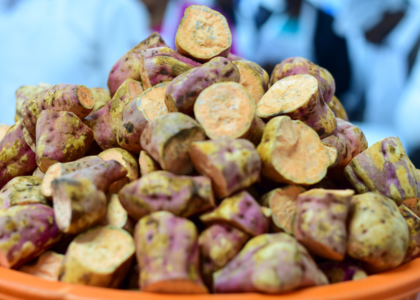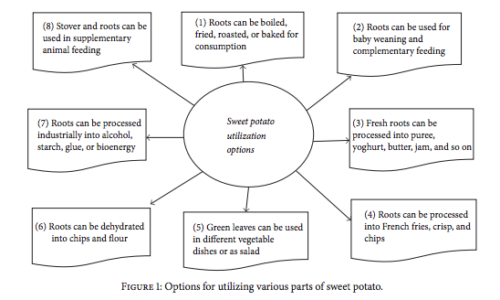In an ongoing effort to lend support to Nigeria’s campaign to reduce poverty and malnutrition amongst its rapidly-growing population, the International Potato Center (CIP) recently hosted a webinar to discuss opportunities for Nigerians within the orange-fleshed sweetpotato value chain.
Nigeria is Africa’s most populous nation with an economy that has recorded an average of 6% growth going back to 2000. Orange-fleshed sweetpotato (OFSP) is an important root crop in Nigeria, where, according to the Food and Agriculture Organization (FAO) of the United Nations, they produce 3.9 million metric tons per year – second only to China globally. Despite these positive indicators, more than half of the country lives below the poverty line, and northern Nigeria suffers the world’s third highest level of chronic undernutrition among children.
OFSP is a powerful tool to address many nutrition problems facing Nigeria, given the crop’s quick maturation, high per unit area useful biomass output, and high nutrition density, especially for vitamin A. The ability to grow sweetpotato in poorly-resourced areas, offers multiple entrepreneurial opportunities across its value chain, especially in the impoverished northern areas of Nigeria. To date, CIP’s work in Africa with numerous partners has led to an improvement in the “nutritional status of more than five million households through development and dissemination of vitamin A rich OFSP varieties,” said Paul Demo, CIP’s Director for Africa, to the audience during the webinar.
 Adegoke Austin Adedamola, the Assistant Chief Agricultural Officer and Desk Officer for the Potato Value Chain at the Federal Ministry of Agriculture and Development, said the Nigerian government is committed to increasing and accelerating the production of OFSP by partnering with other ministries and development partners . To date, three OFSP varieties have been released in Nigeria (in collaboration with CIP): King J, Solo Gold, and Mother’s Delight.
Adegoke Austin Adedamola, the Assistant Chief Agricultural Officer and Desk Officer for the Potato Value Chain at the Federal Ministry of Agriculture and Development, said the Nigerian government is committed to increasing and accelerating the production of OFSP by partnering with other ministries and development partners . To date, three OFSP varieties have been released in Nigeria (in collaboration with CIP): King J, Solo Gold, and Mother’s Delight.
CIP and national partners have developed OFSP varieties that offer traits such as high iron and beta carotene content, and improved resistance to viruses and weevils. For this reason, Edward Nwaogu of the National Root Crop Research Institute, told the audience, “We intend to test and approve these new varieties that meet different end-user and consumer market demands.”
With these various traits, finding the proper target audience is crucial to ensure adoption. Professor Lateef Sanni, from the International Society for Tropical Root Crops, discussed ideas for reaching youth, women and farmers with OFSP products, such as baby food puree, through school feeding programs, and industrial processing puree for market products, among others (Figure 1).
 However, to ensure effective production and expanded use of sweetpotato, partnerships are crucial. In the past, CIP has work with several private sector and non-governmental organizations to help reduce vitamin A deficiency and improve incomes for smallholder farmers. Stephanie Omon Okpere from eHealth Africa shared how her group introduced OFSP to Kano state with funding by German Cooperation. Subsequently, communities were more aware of the nutritional benefits of OFSP and began using the crop as part of their daily diets. Farmers in Kano reported additional income from sale of roots and vines.
However, to ensure effective production and expanded use of sweetpotato, partnerships are crucial. In the past, CIP has work with several private sector and non-governmental organizations to help reduce vitamin A deficiency and improve incomes for smallholder farmers. Stephanie Omon Okpere from eHealth Africa shared how her group introduced OFSP to Kano state with funding by German Cooperation. Subsequently, communities were more aware of the nutritional benefits of OFSP and began using the crop as part of their daily diets. Farmers in Kano reported additional income from sale of roots and vines.
Dr. Augustine Okoruwa (Global Alliance for Improved Nutrition) and Ibiso Ivy King-Harry (Scaling Up Nutrition Business Network) discussed the nutritional impact and possibilities with OFSP as a sustainable food-based intervention and diet diversification approach to combat vitamin A deficiency in Nigeria (see their presentation here).
In all, the webinar attracted more 160 government, development, academia, and research practitioners out of which 100 attended the live session for information.
This event was organized as part of CIP’s Development and Delivery of Biofortified Crops at Scale (DDBIO) project which seeks to scale up the benefits of OFSP more widely and target vulnerable households and communities more explicitly to ensure the benefits of biofortification reach those most in need. The project is being implemented in Bangladesh, Ethiopian, Kenya, Nigeria, and Uganda.
Blog written by Vivian Atakos with contributions from Hemant Nitturkar and Joyce Maru.
